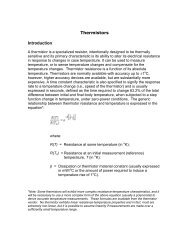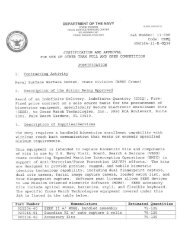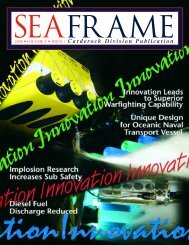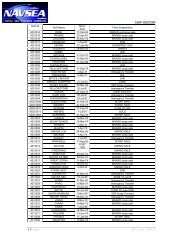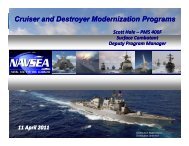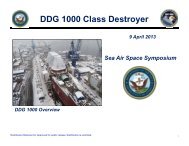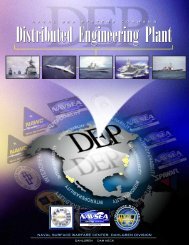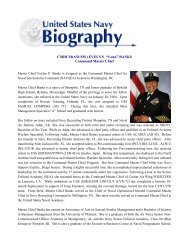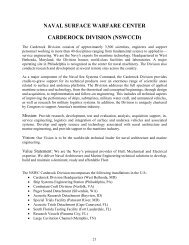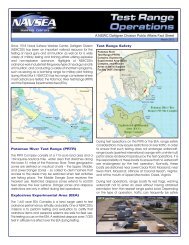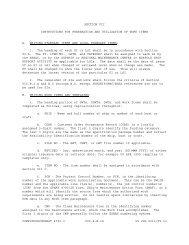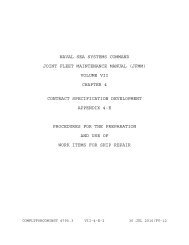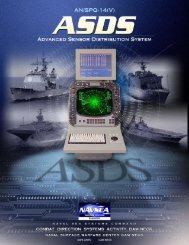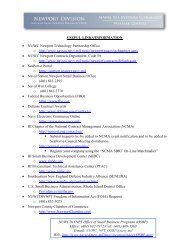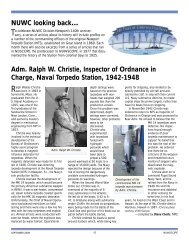Volume 6, Issue 1 - Naval Sea Systems Command - The US Navy
Volume 6, Issue 1 - Naval Sea Systems Command - The US Navy
Volume 6, Issue 1 - Naval Sea Systems Command - The US Navy
Create successful ePaper yourself
Turn your PDF publications into a flip-book with our unique Google optimized e-Paper software.
SEAFRAME<br />
32<br />
By<br />
<strong>The</strong>resa<br />
Vaites<br />
Technology & innovation<br />
Saving the Fleet Fuel Costs,<br />
Weight, and Voltage<br />
On April 1, 2009, the <strong>US</strong>S Higgins<br />
(DDG 76) passed over the U.S. <strong>Navy</strong><br />
Magnetic Silencing Range outside San<br />
Diego, Calif., producing a “full coil” effect.<br />
This successful test run of a new High<br />
Temperature Superconducting (HTS) degaussing system,<br />
was a major milestone in a multi-year project guided<br />
by representatives from <strong>Naval</strong> Surface Warfare Center<br />
Carderock Division’s (NSWCCD’s) Machinery Research<br />
and Silencing, and Underwater Electromagnetic Signature<br />
and Technology divisions, and sponsored by the Office of<br />
<strong>Naval</strong> Research (ONR).<br />
In 2004, ONR tasked these groups with<br />
completing a feasibility study of the use of superconducting<br />
technology for building an advanced degaussing system<br />
for the U.S. <strong>Navy</strong>. It was predicted that the use of a<br />
superconducting cable-based system would provide a<br />
significant cost saving to the fleet over existing degaussing<br />
systems, which require hundreds of meters of copper wire.<br />
<strong>The</strong> results of the study did indeed show that the use of<br />
HTS technology would provide a potential reduction in<br />
installed costs of about 40 percent when compared to a<br />
traditional copper cable-based system.<br />
“<strong>The</strong> HTS coil is made of ceramic material that<br />
replaces the copper coils,” stated Brian Fitzpatrick, lead<br />
project engineer. “<strong>The</strong> superconductivity of this new<br />
degaussing system means less energy is required, yet it<br />
enables greater degaussing performance. Additionally,<br />
there is significant weight savings–up to 80 percent in<br />
some cases.”<br />
<strong>The</strong> HTS degaussing systems projected for<br />
ship classes with advanced degaussing systems show<br />
an estimated 50 to 80 percent reduction in total system<br />
weight, which offers significant potential for fuel savings,<br />
or options to add different payloads. In addition, the HTS<br />
cables have no resistance providing a reduction in operation<br />
from 500.0 volts to 0.5 volts.<br />
HIGH<br />
TEMPERATURE<br />
DEGA<strong>US</strong>SING<br />
<strong>The</strong> advanced degaussing system, developed<br />
by Carderock Division engineers John Holmes,<br />
Milton Lackey, Shirley Steffey, Richard Mack, and<br />
Robert Wingo, neutralizes the magnetic signature of<br />
the ship, created as the steel hull of the ship passes<br />
through the water, in the same manner as a traditional<br />
system. Electrified cables are run on multiple axes of<br />
a ship hull to counteract the magnetic field disruptions<br />
that allow a ship to be “seen” by magnetically<br />
activated mines. Since 1950, mine strikes have caused<br />
77 percent of the U.S. <strong>Navy</strong> ship causalities.<br />
Fitzpatrick, along with engineers Jacob<br />
Kephart, Peter Ferrara, and Michael Pyryt constructed<br />
an initial operational one-loop demonstration<br />
system using commercially available components,<br />
in support of the U.S. <strong>Naval</strong> initiative to make use<br />
of Commercial Off-the-Shelf (COTS) equipment<br />
to provide a cost effective quick transition of<br />
technology to the fleet. A second loop was later<br />
added to the model with the cooling provided by a<br />
single cryocooler to eliminate the significant system<br />
cost of using a second cooler. A call to industry was<br />
also made to solicit proposals for HTS cables that<br />
would be able to withstand the shocks and vibrations<br />
of the naval environment, and for designs of quick<br />
disconnecting cables and junction boxes that would<br />
enable easier maintenance and repair of installed<br />
advanced degaussing systems through the ONR and<br />
NAVSEA PEO Ships Small Business Innovative<br />
Research (SBIR) programs.<br />
HIGH TEMPERATURE DEGA<strong>US</strong>SING (Continued on page 34)



